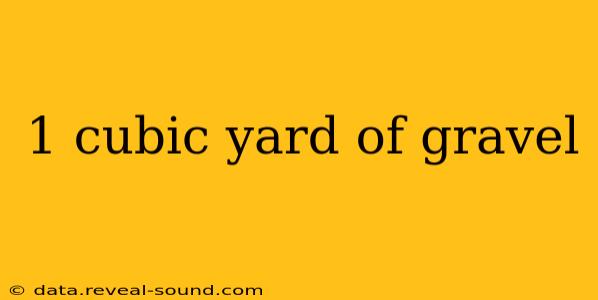Thinking about a landscaping project or need gravel for another purpose? Understanding what a cubic yard of gravel actually represents is crucial for accurate budgeting and material ordering. This guide will help you visualize a cubic yard, understand its applications, and address common questions surrounding this essential measurement.
What Does a Cubic Yard of Gravel Look Like?
Imagine a cube measuring three feet in length, three feet in width, and three feet in height. That's precisely one cubic yard (3ft x 3ft x 3ft = 27 cubic feet). Visualizing this can be tricky, so consider these examples:
- A wheelbarrow: A standard wheelbarrow holds roughly 3-6 cubic feet of material, meaning you'd need 4.5 to 9 wheelbarrows to equal one cubic yard.
- A pickup truck: A standard pickup truck bed can hold approximately 1-1.5 cubic yards, depending on the size and model.
- A large container: A container approximately 3 feet by 3 feet square and 3 feet high would perfectly contain one cubic yard.
Remember that these are rough estimations; the actual volume can vary slightly.
How Much Does a Cubic Yard of Gravel Weigh?
The weight of a cubic yard of gravel varies significantly based on the type of gravel and its moisture content. Generally, a cubic yard of gravel weighs between 2,400 and 2,800 pounds (1.2 to 1.4 tons). This is a crucial factor when considering transportation and project planning. Heavier gravel will require more robust equipment for moving and placing.
How Many Cubic Yards of Gravel Do I Need?
Calculating the required amount is critical to avoid overspending or running short. Here's a simple method:
- Measure the area: Determine the length and width of the area you're covering in feet.
- Calculate the area: Multiply the length by the width to find the square footage.
- Determine the depth: Decide how deep you want the gravel layer to be (in feet).
- Calculate the cubic yards: Multiply the square footage by the depth (in feet) and divide by 27 (since there are 27 cubic feet in a cubic yard).
Example: A 10ft x 10ft area with a 4-inch (1/3 foot) depth of gravel requires: (10ft x 10ft x 1/3ft) / 27 = 1.23 cubic yards. It's always best to round up slightly to ensure you have enough material.
What are the Different Types of Gravel?
Gravel comes in various types, each suited for different applications. Some common types include:
- Pea Gravel: Small, smooth stones, ideal for pathways and driveways.
- River Rock: Naturally rounded stones, often used for decorative purposes.
- Crushed Stone: Angular, sharp stones, often used for driveways and base layers.
- Decorative Gravel: A wide range of colors and sizes, often used for landscaping and aesthetic purposes.
Choosing the right type is important for both functionality and aesthetics.
What is the Cost of a Cubic Yard of Gravel?
The cost per cubic yard fluctuates based on several factors including:
- Type of gravel: Decorative gravels tend to be more expensive than standard crushed stone.
- Location: Transportation costs significantly affect the overall price.
- Supplier: Prices can vary among different suppliers.
It's best to contact local suppliers for accurate pricing in your area.
How is Gravel Delivered?
Gravel is typically delivered in bulk using dump trucks or smaller delivery vehicles depending on the quantity ordered. Ensure you have sufficient space for the delivery truck to access the site and unload safely.
Understanding cubic yard calculations and the various factors impacting gravel selection and cost ensures your project runs smoothly and within budget. Remember to always contact local suppliers for the most accurate pricing and availability information in your area.
